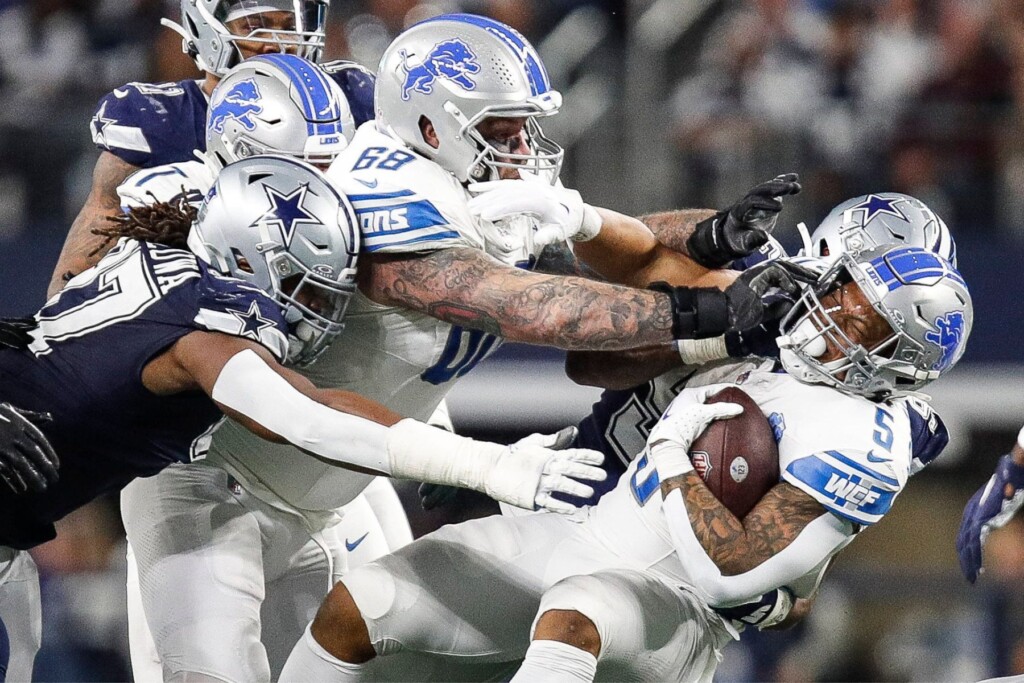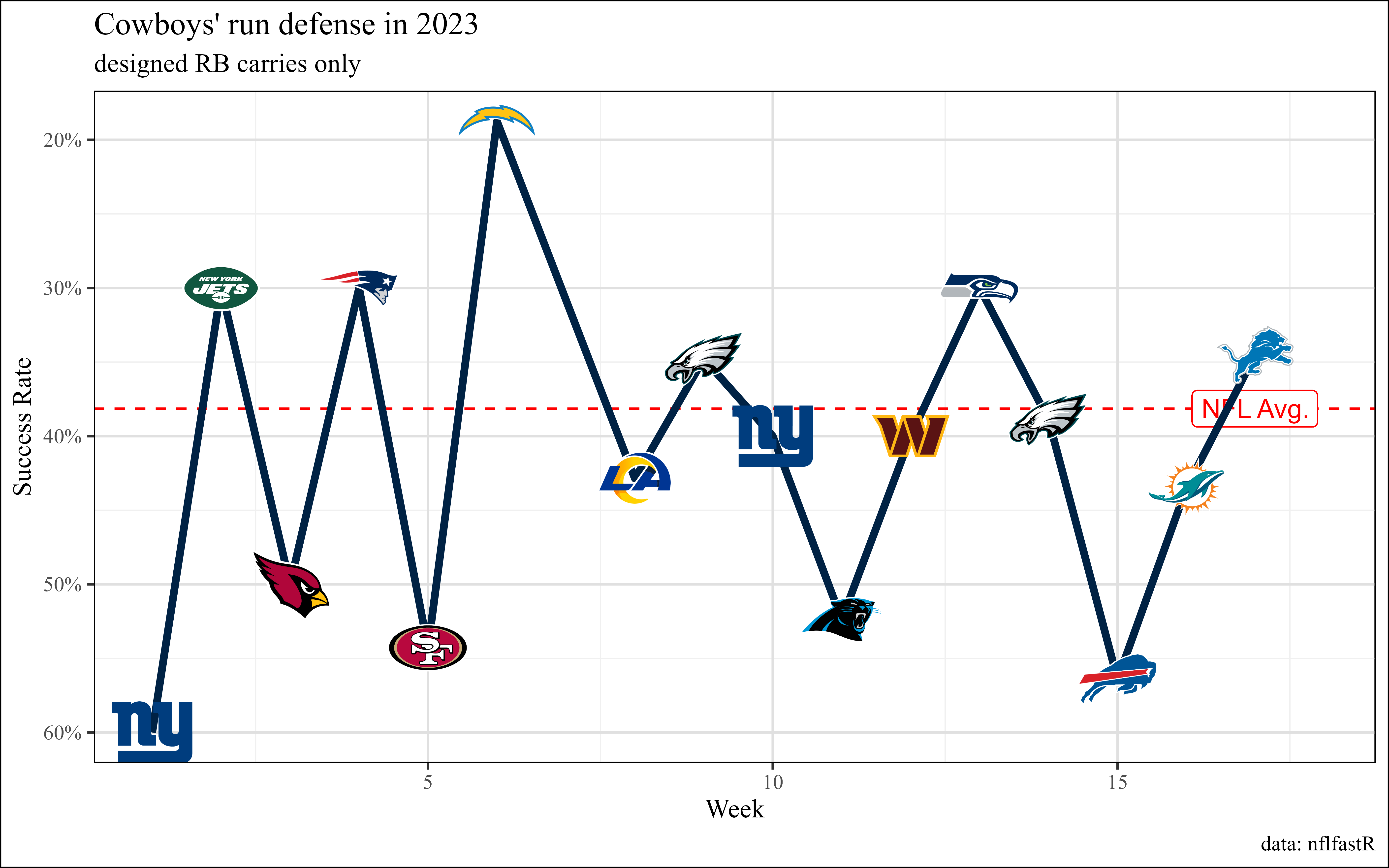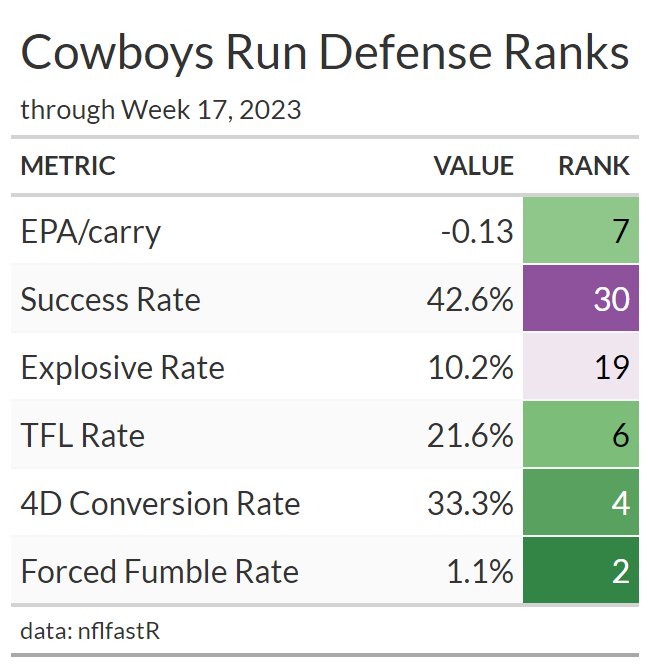The Cowboys put themselves in position to claim the NFC East with a nail-biter of a win last Saturday over the Detroit Lions. The final minutes of this game featured several odd penalties and perhaps even odder coaching decisions, but the end result was still a humongous Cowboys W.
These aren’t the same Lions that fans have watched struggle through decades of mediocrity, either. At 11-5, Detroit features a top-10 offense thanks to Jared Goff’s best season since his 2018 Super Bowl run with the Rams paired with a dual-threat backfield of David Montgomery and Jahmyr Gibbs. But against Dallas, that offense was stymied to the point of tallying only 13 points through 58 minutes.
For the Cowboys, perhaps the most exciting part of this stifling defensive performance was the way in which they slowed the Lions’ one-two punch on the ground. Gibbs, the 12th pick in last spring’s NFL draft, managed just 2.9 yards per carry, a low for him in a game in which he had at least 10 carries. Montgomery fared much better, averaging 4.6 yards per carry and coming up with Detroit’s first touchdown. That dichotomy of running back performances is, in a way, symbolic of how Dallas has handled opposing rushing attacks in recent weeks. And it can boil down to one somewhat outside-the-box number: 5.
That’s how many times over the past six weeks the Cowboys have held opposing running backs to a below-average EPA per carry performance. Using EPA per carry at the team level helps account for some of the variance in rushing situations: for example, an 8-yard carry is great for a running back’s yards per carry, but if it comes on third and 15, well, it wasn’t actually all that helpful, and his EPA per carry will go down.
The point being that over the past six weeks, the Cowboys have been kind of good at stopping the run. Which is a wild assertion considering the beatdown they took from the Bills in Week 15. But the fact is, during this recent stretch, offenses have consistently failed to put themselves in a better position to score when running the ball against the Cowboys.
Some of the success can be attributed to favorable game scripts — the Washington game and the second Philadelphia game weren’t particularly close, and those teams spent a lot of time in passing situations. But the Lions and the Dolphins have some juice in their rushing attacks that just wasn’t effective throughout these games, a promising trend for this Dallas defense.
The problem is that there’s still so much more to the story than this one number can tell.
Looking at the EPA per carry allowed by the Cowboys over the course of the season tells a rather favorable story. They rank seventh in the NFL in EPA per carry allowed to opposing running backs, and even by the more basic yards per carry metric, they rank 12th. If you’ve watched a lot of Cowboys football this year, that might seem surprising to see that ranking so high. And you’d be right to be skeptical. Looking instead at the success rate allowed on opposing rushes by the Cowboys, the defense ranks 30th, with only the Cardinals and Broncos allowing more successful rushes per carry. A successful carry, in this case, is any carry with a positive EPA, meaning a carry that puts the offense in a better position to score. Here’s how that chart above looks if we use success rate as our measure of success
The Detroit game still looks pretty good, but most everything else in the back half of the season has been below average to abysmal.
The cause for the disparity between these two very related metrics isn’t easy to pin down, but as Jake pointed out after the Buffalo loss, it most likely starts with the fact that this team just isn’t built to stop the run. Leighton Vander Esch and Johnathan Hankins are both injured (although Hankins has a chance to make it back against Washington) and Mazi Smith, who was drafted in the first round this year to stuff the middle of the line, ranks 129 out of 137 qualified interior linemen by Pro Football Focus’ run defense grade. Opposing running backs can find lanes fairly consistently, leading to an array of smaller chunk plays that are net positives for the opposing offense.
The reason the value of these run plays isn’t all that high—leading to a good-looking number in terms of the EPA per carry allowed—is that the splash plays in the run game tend to go in the Cowboys’ favor. Dallas has one of the better secondaries in the league in a lot of ways, but an underrated aspect is the unit’s tackling ability: DaRon Bland, Stephon Gilmore, Malik Hooker, and Jourdan Lewis all have a missed tackle rate under 9 percent, per PFF. The Texans are the only other team in the league to have as many defensive backs with such a low missed tackle rate. That helps limit the damage of an explosive run play, keeping it closer to 10 yards rather than the 50-yard home run. Then there’s the ever-present danger of Micah Parsons and DeMarcus Lawrence, who can still make plays in the run game as well as the pass rush. This season the pair has racked up 10 and 9 tackles at or behind the line of scrimmage, respectively, on handoffs to a running back.
So while the Cowboys haven’t been great against the run on a play-to-play basis, they’re making up for it with splash plays. Dallas is among the NFL’s best at getting to running backs behind the line of scrimmage, at forcing fumbles on run plays, and at shutting down fourth-down conversion attempts on the ground. These three categories together still make up a minority of team rushing attempts, but the swing in EPA is so large that we’ve ended up with an overall successful outlook of the defense over the course of the season.
Is this a sustainable way to defend against the run? Well, as we’ve seen, it’s certainly not effective week in, week out. The Lions game offered a glimpse into how Dallas can limit the damage allowed on the ground, but the consistency hasn’t been there. Looking ahead to potential playoff matchups with teams like the Rams and 49ers, who are built on strong rushing attacks, should make any Cowboys fan a touch uneasy. On the right day, this team can do more than enough in run defense to win. On the wrong one? Just hope Los Angeles and San Francisco don’t channel their inner Buffalo and send the Cowboys home early.
Author










